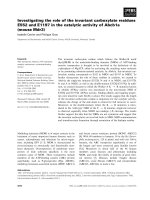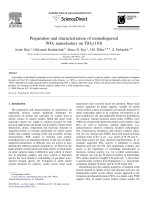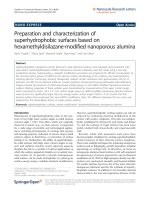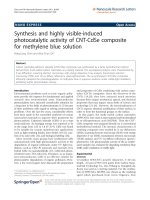Microwave-assisted synthesis and characterization of Co(II) phthalocyanine and investigation of its catalytic activity on 4-nitrophenol oxidation
Bạn đang xem bản rút gọn của tài liệu. Xem và tải ngay bản đầy đủ của tài liệu tại đây (126.13 KB, 8 trang )
Turkish Journal of Chemistry
/>
Research Article
Turk J Chem
(2014) 38: 1166 – 1173
ă ITAK
c TUB
doi:10.3906/kim-1405-42
Microwave-assisted synthesis and characterization of Co(II) phthalocyanine and
investigation of its catalytic activity on 4-nitrophenol oxidation
˘
˙
Ece Tu˘
gba SAKA∗, Zekeriya BIYIKLIOGLU,
Halit KANTEKIN
Department of Chemistry, Faculty of Science, Karadeniz Technical University, Trabzon, Turkey
Received: 16.05.2014
•
Accepted: 22.07.2014
•
Published Online: 24.11.2014
•
Printed: 22.12.2014
Abstract: In this study, new cobalt phthalocyanine containing a 2-(2-benzothiazolylthio)ethoxy group at peripheral
positions has been synthesized and characterized by spectroscopic methods (IR, UV-Vis elemental analysis, and mass
spectroscopies). Catalytic activity of Co(II) phthalocyanine has been investigated in the presence of oxidants such as
tert-buthylhydroperoxide, m-chloroperoxybenzoic acid, and H 2 O 2 . Co(II) phthalocyanine shows catalytically activity
and product conversion under mild conditions. To find the optimal conditions in the oxidation process, substrate ratio,
oxidant ratio, temperature, and oxidant type were examined over 3 h. The results exhibit the best optimum reaction
conditions in this catalytic system.
Key words: Phthalocyanine, microwave irradiation, cobalt, 4-nitrophenol oxidation,oxidant
1. Introduction
Phthalocyanine molecules have been investigated for important applications in technological and scientific areas
due to their color, thermal stability, and luminescence properties. 1,2 For example, they are used in liquid crystals,
photosensitizers, nonlinear optics, solar cells, catalysis, and various chemical sensing applications. 3 Because
phthalocyanines have planar heterocyclic systems, their primary disadvantage is their tendency to aggregate,
which results in low solubility and diffuculties during purification and characterization. Due to the insolubility
of phthalocyanines in organic and/or inorganic solvents, one of the most significant aims of research on the
chemistry of phthalocyanines is to improve their solubility in various solvents. 4,5 Phthalocyanines obtained
from substitution to the peripheral or nonperipheral positions of long or voluminous alkyl chains are provided
in order to dissolve in common organic solvents. Phthalocyanines that dissolve in water are reached by adding
sulfonyl, carboxyl, or quaternary amino groups. 6,7
Metal phthalocyanines are generally obtained in high yields by cyclotetramerization of different organic
molecules with a metal salt at high temperatures. 8,9 On the other hand, increased attention has been focused
on the application of microwave irradiation in the synthesis of metal phthalocyanines for last 10 years. Various
reactions including synthesis reaction of phthalocyanines are carried out under microwave-assisted conditions
in which significant rate enhancements, improved yield and selectivity, and reduction in thermal by-products
have been achieved. 3,10−16
Para-nitrophenols are employed as a raw material in several industries. Because of their toxicity to the
environment and the spreading of large volumes of contamination into the environment, phenol and substituted
phenol compounds are intensively studied for removal from wastewaters. 17
∗ Correspondence:
1166
ece t
SAKA et al./Turk J Chem
Co(II) phthalocyanines complexes are catalysts widely used to carry oxygen from different oxygen donors
to organic molecules in a great number of works. 18−21 Unfortunately, Co(II) phthalocyanines are rarely available
catalysts on 4-nitrophenol oxidation. 22 Therefore, we report microwave-assisted synthesis and characterization
of substituted Co(II) phthalocyanines peripherally containing a 2-(2-benzothiazolylthio)ethoxy group. The
catalytic demeanor of this complex in oxidation of 4-nitrophenol with changing substrate/catalyst ratio, type
of oxidant, and temperature is also explored.
2. Results and discussion
2.1. Syntheses and characterization
The synthetic route to novel peripherally tetra-substituted cobalt phthalocyanine 4 is demonstrated in Figure 1.
Cyclotetramerization of 3 happened in the presence of CoCl 2 to reach the target complex 4. The phthalonitrile
3 was obtained and the new cobalt phthalocyanine was purified according to the literature. 23 The product was
obtained in a yield of 53% and was characterized by spectral data (IR, UV-Vis, and mass spectroscopies). The
spectral data confirm the formation of complex 4.
CN
CN
N
N
S
S
OH
O2N
S
O
CN
S
CN
3
2
1
i
N
S
S
N
S
S
O
O
N
N
N
N
Co
N
N
N
N
O
O
S
S
N
S
S
4
N
Figure 1. Chemical pathway of the cobalt(II) phthalocyanine 4. Synthesis of (i) 2-(dimethylamino)ethanol at 175
◦
C
and 350 W for 8 min by microwave oven.
1167
SAKA et al./Turk J Chem
The IR spectra reveal the formation of complex 4 with the disappearance of absorption bands at 2227
cm
−1
(C≡ N). The 1 H NMR and
13
C NMR spectra of complex 4 could not be taken due to the paramagnetic
cobalt(II) centers. In the mass spectra of complex 4 the presence of a molecular ion peak at m/z = 1348
[M-Co] + confirmed the proposed structure. 24
UV spectra of phthalocyanines including Q and B bands are known. Q band limits are 600–720 nm
and B band limits are 250–350 nm in the visible region. 25 The electronic absorption spectra of complex 4 in
chloroform at room temperature is shown in Figure 2. In UV-Vis spectra of complex 4 (in CHCl 3 ) split Q
bands appeared at 677 and 614 nm, while the B band remained at 281 nm.
2
Absorbance
1.5
1
0.5
0
200
300
400
500
600
700
800
900
Wavelength (nm)
Figure 2. UV-Vis spectrum of complex 4 in CHCl 3 .
2.2. Catalytic studies
A typical catalytic reaction was carried out according to the literature. 26 In order to control the experiments,
4-nitrophenol oxidation with tert-buthylhydroperoxide (TBHP), m-chloroperoxybenzoic acid (m-CPBA), and
H 2 O 2 was done in the absence of the catalyst under the same reaction conditions. The results proved that
the catalyst plays a prominent role in the oxidation process. Tables 1–3 show that comparative studies of the
catalytic activity of complex 4 for oxidation of 4-nitrophenol revealed that the complex is an active catalyst
in DMF. The oxidation products of 4-nitrophenol are benzoquinone as the main product and hydroquinone as
a minor product (Figure 3). To achieve the highest conversion of the substrate, the catalytic reactions were
carried out while changing the reaction temperature, time, oxidants, and substrate/catalyst ratio.
OH
OH
O
OH
O
oxidant
catalyst (CoPc)
NO 2
4-Nitrophenol
Hydroquinone
Benzoquinone
Figure 3. Product formed through oxidation of 4-nitrophenol by TBHP, m-CPBA, and H 2 O 2 in the presence of
complex 4.
The results of the catalytic oxidation of 4-nitrophenol by TBHP in the presence of complex 4 are shown
in Figure 4. Higher yield was obtained for benzoquinone than hydroquinone for this catalyst. The yield of
1168
SAKA et al./Turk J Chem
the 2 products increased, but leveled off with time. This situation occurs due to the degradation of the Co(II)
phthalocyanine by the oxidant.
120
Benzoquinone
Conversion (%)
100
Hydroquinone
4-Nitrophenol
80
60
40
20
0
0
50
100
150
200
Figure 4. Time-dependent conversion of 4-nitrophenol oxidation. Reaction conditions: 0.71 × 10 −3 mol 4-nitrophenol,
1.06 × 10 −3 mol TBHP, 3.55 × 10 −6 mol complex 4 in 10 mL DMF at 90
◦
C.
Table 1 shows the results when the molar ratio (substrate/catalyst) was varied (200–800). The other
reaction parameters were 90 ◦ C, 1.06 × 10 −3 mol TBHP, and 0.01 L DMF for 3 h. As predicted, with a decrease
in the substrate/catalyst molar ratio, the conversion amount increases. At each different substrate/catalyst
ratio, the oxidation of 4-nitrophenol gives the same main product (benzoquinone) with selectivity of 57.7% for
complex 4.
Table 1. Effect of amount of substrate on 4-nitrophenol oxidation with complex 4.
Entry
1
2
3
4
5
6
Subs./cat.
200/1
300/1
400/1
500/1
600/1
800/1
Benzoquinone
61
54
48
39
26
19
Hydroquinone
37
32
32
21
20
19
Tot. conv. (%)
98
86
80
60
56
38
TONa
196
258
320
300
336
304
TOFb (h−1 )
65
86
106
100
112
101
a
TON = moles of product/moles of catalyst.
TOF = moles of product/moles of catalyst × time.
Conversion was determined by GC.
Reaction conditions: 90 ◦ C, 1.06 × 10−3 mol TBHP, 3.55 × 10−6 mol complex 4, 0.01 L DMF for 3 h.
b
The effect of the oxygen source on the reaction rate of 4-nitrophenol oxidation was investigated for TBHP,
m-CPBA, aerobic oxygen, and H 2 O 2 . With the exception of the oxidant, all the experimental conditions were
kept constant for the catalytic reactions. The data are given in Table 2 and Figure 5. There was no conversion
for complex 4 when aerobic oxygen was used as the oxidant. The results showed that complex 4 exhibits
significantly higher activity with TBHP than the other studied oxidants. The control experiment showed that
the 4-nitrophenol was not oxidized in the absence of an oxidant. Study of the influence of temperature on the
oxidation of 4-nitrophenol with complex 4 showed that as the reaction temperature was raised, the catalyst
activity increased. The experiments were conducted at different temperatures (25 ◦ C, 50 ◦ C, 70 ◦ C, 90 ◦ C)
while the other reaction parameters were unchanged (Table 3). The total conversion was increased by 43%
when the temperature was raised beyond 90
for complex 4 at 90 ◦ C.
◦
C. The highest conversion (86%) was obtained with TOF = 86
1169
SAKA et al./Turk J Chem
Table 2. Effect of different oxidants on 4-nitrophenol oxidation with complex 4.
Entry
1
2
3
4
5
6
Oxidant
TBHP
H2 O2
m-CPBA
Air oxygen
No oxidant
TBHP*
Benzoquinone
61
46
31
-
Hydroquinone
37
25
19
-
Tot. conv. (%)
98
71
50
-
TONa
196
142
100
-
TOFb (h−1 )
65
47
33
-
a
TON = moles of product/moles of catalyst.
TOF = moles of product/moles of catalyst × time.
Conversion was determined by GC.
*The oxidation reaction was done without complex 4.
Reaction conditions: 90 ◦ C, 0.71 × 10−3 mol 4-nitrophenol, 1.06 × 10−3 mol TBHP, 3.55 × 10−6 mol
complex 4, 0.01 L DMF for 3 h.
b
Table 3. Effect of temperature on 4-nitrophenol oxidation with complex 4.
Entry
1
2
3
4
T (◦ C).
90
70
50
25
Benzoquinone
54
47
35
21
Hydroquinone
32
32
27
22
Selectivitya
62
59
56
48
Tot. conv. (%)
86
79
62
43
TONb
258
237
186
129
TOFc (h−1 )
86
79
62
43
a
Benzoquinone.
TON = moles of product/moles of catalyst.
c
TOF = moles of product/moles of catalyst × time.
Conversion was determined by GC.
Reaction conditions: 90 ◦ C, 1.06 × 10−3 mol 4-nitrophenol, 1.06 × 10−3 mol TBHP, 3.55 × 10−6 mol complex 4,
0.01 L DMF for 3 h.
b
70
Benzoquinone
Hydroquinone
Total conversion (%)
60
50
40
30
20
10
0
TBHP
H2O2
m-CPB
Free oxidant
Oxidant
Figure 5. The oxidant effect on 4-nitrophenol oxidation.
Very few works on 4-nitrophenol oxidation with a Co(II) phthalocyanine catalyst are available. Bıyıklıo˘glu
et al. used 4-[4-((E)-{[4-(dimethylamino)phenyl]imino} methyl)phenoxy] substituted Co(II) phthalocyanine
catalyst and TBHP, m-CPBA, and H 2 O 2 oxidants in the oxidation of 4-nitrophenol. They observed that
Co(II) phthalocyanine had high total conversion (96%) and turnover number (TON: 190). Moreover, that
study demonstrated the fast degradation of the phthalocyanine ring in the complex when m-CPBA and H 2 O 2
were employed as an oxidants. 22 In our work, complex 4 was found to be a more active catalyst in the oxidation
of 4-nitrophenol with high conversion and turnover number (98% and TON: 196).
1170
SAKA et al./Turk J Chem
In addition to these parameters, changing of the catalysts was studied by UV-Vis spectrophotometer
during the oxidation reaction. Degradation of Co(II) phthalocyanine is a frequent situation in oxidation
processes with the addition of an oxidant. 27−29 It was seen that Co(II) phthalocyanine in chloroform has a
distinctive sharp vibronic Q band due to the monomeric species in the absence of an oxygen source. 1 As the
oxidation reaction proceeds, this Q band shifts to 662 nm, broadens, and disappears at the end of the reaction.
The shift from 654 to 662 nm attested to the metal oxidation of M(II)-Pc to M(III)-Pc (Figure 6). 30 After 3
h, this oxidized intermediate decomposed. There was no further conversion of any products. As the reaction
time progresses, the widening and disappearing of the Q band are seen as in Co(II) phthalocyanine. 31 This
situation is due to the result of the attack of the phthalocyanine ring by the alkyl and alkoxy radicals that are
produced from TBHP. The color of the solution changed from blue to green as catalysis progressed. However,
the reaction products continued to form even after the catalyst had turned yellow, suggesting that once reaction
intermediates are formed, the reaction can still proceed in the presence or absence of the original form of the
catalyst.
1
0.9
Absorbance
0.8
0.7
a
0.6
b
0.5
c
0.4
d
0.3
e
0.2
f
0.1
0
500
550
600
650
700
750
800
Wavelength (nm)
Figure 6. Time-dependent changes in the visible spectrum of oxidized complex 4 observed upon addition of TBHP
(1.06 × 10 −3 mol) to a reaction mixture containing 0.71 × 10 −3 mol 4-nitrophenol and 3.55 × 10 −6 mol complex 4
catalyst in 10 mL: (b) 36 min, (c) 72 min, (d) 108 min, (e) 144 min, (f) 180 min after addition of TBHP. All spectra for
oxidized complex 4 were taken after 6-fold dilution with DMF. (a) shows the visible spectrum of (nonoxidized) complex 4.
3. Experimental
3.1. Measurements
The general procedure for the oxidation of 4-nitrophenol and measurements were done according to the
literature. 23 All materials used in this work were obtained according to the literature. 23,32,33
3.2. Synthesis of peripherally tetra-substituted cobalt(II) phthalocyanine (4)
2-(2-Benzothiazolylthio)ethoxy phthalonitrile 3 (0.5 g, 1.48 mmol), CoCl 2 (95 mg, 0.74 mmol), and 2-(dimethylamino)ethanol (5 mL) were irradiated in a microwave oven at 175 ◦ C and 350 W for 8 min. After cooling to
room temperature, the reaction mixture was refluxed with ethanol to precipitate the product, which was filtered
off and dried in vacuo over P 2 O 5 . The obtained green solid product was purified by column chromatography
on alumina with chloroform and methanol (8:2) as the solvent system. Yield: 0.280 g (53%), mp >300 ◦ C.
1171
SAKA et al./Turk J Chem
(KBr tablet) vmax / cm −1 : 3056 (Ar-H), 2955–2931 (aliph. C-H), 1664, 1609, 1522, 1483, 1343, 1277, 1237,
1096, 1070, 994, 824, 753. UV-Vis (CHCl 3 ), λmax (logε) nm: 677 (4.45), 614 (4.17), (4.60), 281 (5.10).
4. Conclusion
In this study, all spectroscopic data of Co(II) phthalocyanine showed successful synthesis. Catalytic activities
of Co(II) phthalocyanine were then investigated by examining the effects of certain parameters. Co(II) phthalocyanine showed catalytic performance in 4-nitrophenol oxidation with benzoquinone conversion (61%) when
using TBHP as an oxidant. In conclusion, this catalytic work is feasible and time-saving in terms of procedure
and we have determined the best oxidation conditions for complex 4 with high TON and TOF values.
Acknowledgment
This study was supported by the Research Fund of Karadeniz Technical University, Project No: 9666 (Trabzon,
Turkey).
References
1. Leznoff, C. C.; Lever, A. B. P. Phthalocyanines: Properties and Applications; VCH: New York, NY, USA, 1989.
2. Moser, F. H.; Thomas, A. The Phthalocyanines, Vol. 1 ; Boca Raton, FL, USA: CRC Press, 1983.
ă Dindar, B.; Gă
3. Seven, O.;
ultekin, B. Turk. J. Chem. 2009, 33, 123–134.
4. Sakamoto, K.; Kato, T.; Ohno-Okomura, E.; Watanabe, M.; Cook, M. J. Dyes Pigments 2005, 64, 67–75.
5. Kostka, M.; Zimcik, P.; Miletin, M.; Klemera, P.; Kopecky, K.; Musil, Z. J. Photoch. Photobio. A 2006, 178, 16–25.
6. Bıyıklıo˘
glu, Z.; Durmu¸s, M.; Kantekin, H. J. Photochem. Photobio. A 2011, 222, 87–96.
7. Acar, I.; Cakır, V.; Bıyıklıoglu, Z.; Kantekin, H. Synthetic Met. 2012, 162, 1156–1163.
8. McKeown, N. B. J. Mater. Chem. 2000, 20, 10588–10597.
9. Agboola, B. O. PhD, Division of Chemistry, Rhodes University, Grahamstown, South Africa, 2007.
10. Lokesh, K. S.; Uma, N.; Ahcar, B. N. Polyhedron 2009, 28, 1022–1028.
11. Bıyıklıoglu, Z.; Kantekin, H. Transit. Metal Chem. 2007, 32, 851–856.
12. Bıyıklıo˘
glu, Z.; Guner, E. T.; Topcu, S.; Kantekin, H. Polyhedron 2008, 27, 1707–1713.
13. Kantekin, H.; Bıyıklıo˘
glu, Z.; Celenk, E. Inorg. Chem. Commun. 2008, 11, 633–635.
˙ Bekta¸s, H.; Kantekin, H. J. Organomet. Chem. 2008, 693, 3425–3429.
14. Bekircan, O.; Bıyıklıo˘
glu, Z.; Acar, I.;
15. Kantekin, H.; Dilber, G.; Bıyıklıoglu, Z. J. Organomet. Chem. 2008, 693, 1038–1042.
16. Bıyıklıo˘
glu, Z.; Kantekin, H. Dyes Pigments, 2009, 80, 17–21.
17. Martin-Hernandez, M.; Carrera, J.; Suarez-Ojeda, M. E.; Besson, M.; Descorme, C. Appl. Catal. B-Environ. 2012,
123, 141–150.
18. Rao, T. V.; Rao, K. N.; Jain, S. L.; Sain, B. Synthetic Commun. 2012, 32, 11511157.
19. Cimen, Y.; Tă
urk, H. Appl. Catal. A-Gen. 2008, 340, 5258.
ă
20. Ylmaz, F.; Ozer,
M.; Kani, I.; Bekaroglu O. Catal. Lett. 2009, 130, 642–647.
21. Saka, E. T.; Bıyıklıo˘
glu, Z.; Kantekin, H.; Kani, I. Appl. Organometal. Chem. 2013, 27, 59–67.
22. Acar, I.; Bayrak, R.; Saka, E. T.; Bıyıklıoglu, Z.; Kantekin, H. Polyhedron 2013, 50, 345–353.
23. Saka, E. T.; Ersoy, N.; Gă
ol, C.; Durmuás, M.; Byklo
glu, Z.; Kantekin, H. J. Organomet. Chem. 2013, 723, 1–9.
1172
SAKA et al./Turk J Chem
24. Durmus, M.; Erdo˘
gmus, A.; Ogunsipe, A.; Nyokong, T. Dyes Pigments, 2009, 82, 244250.
25. Gă
urol, I.; Ahsen, V.; Bekaro˘
glu, O. J. Chem. Soc. Dalton Trans. 1994, 4, 497–500.
26. Saka, E. T.; Bıyıklıoglu, Z. J. Organomet. Chem. 2013, 756–746, 50–56.
˙ Inorg. Chem. Commun. 2008, 11, 1448–1451.
27. Bıyıklıo˘
glu, Z.; Kantekin, H.; Acar, I.
28. Akinbulu, I. A.; Nyokong, T. Polyhedron 2010, 29, 1257–1270.
29. Alemdar, A.; Ozkaya, A. R.; Bulut, M. Polyhedron 2009, 28, 3788–3396.
30. Zhao, F.; Zhang, J.; Abe, T.; Wă
ohrle, D.; Kaneko, M. J. Mol. Catal. A Chem. 1999, 145, 245–256.
31. Sehlotho, N.; Nyokong, T. J. Mol. Catal. A Chem. 2004, 219, 201–207.
32. Perin, D. D.; Armarego, W. L. F. Purification of Laboratory Chemicals, 2nd ed.; Pegamon Press: Oxford, UK,
1989.
33. Young, J. G.; Onyebuagu, W. J. J. Org. Chem. 1990, 55, 2155–2159.
1173









